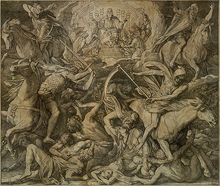White Horse

Based on the above passage, a common translation into English is the rider of the White Horse (sometimes referred to as the White Rider). He is thought to carry a bow (Greek τόξο, toxo) and wear a victor's crown (Greek stephanos).
As Christ or the Gospel or the Holy Spirit
Irenaeus, an influential Christian theologian of the 2nd century, was among the first to interpret this Horseman as Christ himself, his white horse representing the successful spread of the gospel.[3] Various scholars have since supported this notion,[8] citing the later appearance, in Revelation 19, of Christ mounted on a white horse, appearing as The Word of God. Furthermore, earlier in the New Testament, the Book of Mark indicates that the advance of the gospel may indeed precede and foretell the apocalypse.[3][9] The color white also tends to represent righteousness in the Bible, and Christ is in other instances portrayed as a conqueror.[3][9]
Besides Christ, the Horseman could represent the Holy Spirit. The Holy Spirit was understood to have come upon the Apostlesat Pentecost after Jesus' departure from Earth. The appearance of the Lion in Revelation 5 shows the triumphant arrival of Jesus in Heaven, and the first Horseman could represent the sending of the Holy Spirit by Jesus and the advance of the gospel of Jesus Christ.[10]
As the Antichrist
While for nearly nineteen centuries Christians had thought that the first horseman was a positive figure representing either Christ or the Gospel, a completely different interpretation of this character emerged in 1866[11] when C.F. Wimpel defended the first hypothesis that he was the Antichrist (and more precisely according to him Napoleon Bonaparte).[12] It was taken over from the next generation in the United States by R. F. Franklin in 1898[13] and W. C. Stevens in 1928[14] and was then very successful in evangelical circles until today, for example with Pastor Billy Graham, for whom it was the Antichrist or false prophets in general.[15] This hypothesis is now spreading throughout the world through evangelical churches.
As Roman Empire prosperity

According to Edward Bishop Elliott's interpretation, that the Four Horsemen represent a prophecy of the subsequent history of the Roman Empire, the white color of this horse signifies triumph, prosperity and health in the political Roman body. For the next 80 or 90 years succeeding the banishment of the apostle John to Patmos covering the successive reigns of the emperors Nerva, Trajan, Hadrian and the two Antonines (Antoninus Pius and Marcus Aurelius), a golden age of prosperity, union, civil liberty and good government unstained with civil blood unfolded. The agents of this prosperity personified by the rider of the white horse are these five emperors wearing crowns that reigned with absolute authority and power under the guidance of virtue and wisdom, the armies being restrained by their firm and gentle hands.[16]:129–131,134
This interpretation points out that the bow was preeminently a weapon of the inhabitants of the island of Crete and not of the Roman Empire in general. The Cretans were renowned for their archery skills. The significance of the rider of the white horse holding a bow indicates the place of origin of the line of emperors ruling during this time. This group of emperors can be classed together under one and the same head and family whose origins were from Crete.[16]:140,142–144
According to this interpretation, this period in Roman history, remarkable, both at its commencement and at its close, illustrated the glory of the empire where its limits were extended, though not without occasional wars, which were always uniformly triumphant and successful on the frontiers. The triumphs of the Emperor Trajan, a Roman Alexander, added to the empire Dacia, Armenia, Mesopotamia and other provinces during the course of the first 20 years of the period, which deepened the impression on the minds of the barbarians of the invincibility of the Roman Empire. Roman war progressed triumphantly into the invader's own territory, and the Parthian war was successfully ended by the total overthrow of those people. Roman conquest is demonstrated even in the most mighty of these wars, the Marcomannicsuccession of victories under the second Antonine unleashed on the German barbarians, driven into their forests and reduced to Roman submission.[16]:131–133
As war
In some commentaries to Bibles, the white Horseman is said to symbolize (ordinary) War, which may possibly be exercised on righteous grounds in decent manner, hence the white color, but still is devastating. The red Horseman (see below) then rather more specifically symbolizes civil war.[17]
As infectious disease
Under another interpretation, the first Horseman is called Pestilence, and is associated with infectious disease and plague. It appears at least as early as 1906, when it is mentioned in the Jewish Encyclopedia.[18] This particular interpretation is common in popular culture references to the Four Horsemen.[19]
The origin of this interpretation is unclear. Some translations of the Bible mention "plague" (e.g. the NIV) or "pestilence" (e.g. the RSV) in connection with the riders in the passage following the introduction of the fourth rider; cf. "They were given power over a fourth of the earth to kill by sword, famine, plague, and by the wild beasts of the earth." (Revelation 6:7–8 NASB). However, it is a matter of debate as to whether this passage refers to the fourth rider only, or to the four riders as a whole.[1]
Vicente Blasco Ibáñez, in his 1916 novel The Four Horsemen of the Apocalypse (filmed in 1921 and in 1962), provides an early example of this interpretation, writing "The horseman on the white horse was clad in a showy and barbarous attire. ... While his horse continued galloping, he was bending his bow in order to spread pestilence abroad. At his back swung the brass quiver filled with poisoned arrows, containing the germs of all diseases."[20


No comments:
Post a Comment